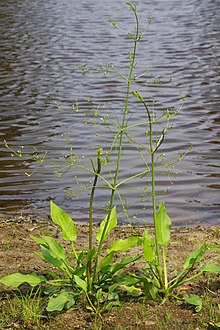Alismatales
| Alismatales | |
|---|---|

| |
| Alisma plantago-aquatica | |
| Scientific classification | |
| Kingdom: | Plantae |
| Clade: | Tracheophytes |
| Clade: | Angiosperms |
| Clade: | Monocots |
| Order: | Alismatales |
| Families | |
|
See Taxonomy | |


The Alismatales (alismatids) are an order of
Description
The Alismatales comprise
Both marine and freshwater forms include those with staminate flowers that detach from the parent plant and float to the surface. There they can pollinate carpellate flowers floating on the surface via long pedicels.[3] In others, pollination occurs underwater, where pollen may form elongated strands, increasing chance of success. Most aquatic species have a totally submerged juvenile phase, and flowers are either floating or emerge above the water's surface. Vegetation may be totally submersed, have floating leaves, or protrude from the water. Collectively, they are commonly known as "water plantain".[4]
Taxonomy
The Alismatales contain about 165 genera in 13 families, with a
Early systems
The Cronquist system (1981) places the Alismatales in subclass Alismatidae, class Liliopsida [= monocotyledons] and includes only three families as shown:
- Alismataceae
- Butomaceae
- Limnocharitaceae
Cronquist's subclass Alismatidae conformed fairly closely to the order Alismatales as defined by APG, minus the Araceae.
The
- Alismataceae
- Aponogetonaceae
- Butomaceae
- Hydrocharitaceae
- Limnocharitaceae
In Tahktajan's classification (1997), the order Alismatales contains only the Alismataceae and Limnocharitaceae, making it equivalent to the Alismataceae as revised in APG-III. Other families included in the Alismatates as currently defined are here distributed among 10 additional orders, all of which are assigned, with the following exception, to the Subclass Alismatidae. Araceae in Tahktajan 1997 is assigned to the Arales and placed in the Subclass Aridae; Tofieldiaceae to the Melanthiales and placed in the Liliidae.[7]
Angiosperm Phylogeny Group
The Angiosperm Phylogeny Group system (APG) of 1998 and APG II (2003) assigned the Alismatales to the monocots, which may be thought of as an unranked clade containing the families listed below. The biggest departure from earlier systems (see below) is the inclusion of family Araceae. By its inclusion, the order has grown enormously in number of species. The family Araceae alone accounts for about a hundred genera, totaling over two thousand species. The rest of the families together contain only about five hundred species, many of which are in very small families.[8]
The
- order Alismatales sensu APG III
- family Alismataceae (including Limnocharitaceae)
- family Aponogetonaceae
- family Araceae
- family Butomaceae
- family Cymodoceaceae
- family Hydrocharitaceae
- family Juncaginaceae
- family Posidoniaceae
- family Potamogetonaceae
- family Ruppiaceae
- family Scheuchzeriaceae
- family Tofieldiaceae
- family Zosteraceae
In
| Cladogram of Alismatales[2] | |||||||||||||||||||||||||||||||||||||||||||||||||||||||||||||||||||||||||||
|
- family Alismataceae (including Limnocharitaceae)
- family Aponogetonaceae
- family Araceae
- family Butomaceae
- family Cymodoceaceae
- family Hydrocharitaceae
- family Juncaginaceae
- family Maundiaceae
- family Posidoniaceae
- family Potamogetonaceae
- family Ruppiaceae
- family Scheuchzeriaceae
- family Tofieldiaceae
- family Zosteraceae
Phylogeny
Cladogram showing the orders of monocots (Lilianae sensu Chase & Reveal)[10] based on molecular phylogenetic evidence:
Alismatid monocots |
References
- ^ hdl:10654/18083
- ^ a b Stevens, P.F. (2022). "Alismatales". Angiosperm Phylogeny Website. 14. Missouri Botanical Garden. Retrieved 28 October 2022.
- S2CID 13369438.
- ^ "-Alismatales (Water Plantains)" (PDF). Archived from the original (PDF) on 12 June 2010. Retrieved 27 May 2010.
- ^ Wilkin & Mayo 2013.
- ^ RBG 2010.
- ^ "-Flowering Plant Gateway". Archived from the original on 6 October 2011. Retrieved 27 May 2010.
- ^ a b APG IV 2016.
- ^ Christenhusz et al. (2015)
- ^ a b Chase & Reveal 2009.
Further reading
- B. C. J. du Mortier1829. Analyse des Familles de Plantes : avec l'indication des principaux genres qui s'y rattachent. Imprimerie de J. Casterman, Tournay
- W. S. Judd, C. S. Campbell, E. A. Kellogg, P. F. Stevens, M. J. Donoghue, 2002. Plant Systematics: A Phylogenetic Approach, 2nd edition. Sinauer Associates, Sunderland, Massachusetts ISBN 0-87893-403-0.
- Wilkin, Paul; Mayo, Simon J, eds. (2013). Early events in monocot evolution. Cambridge: Cambridge University Press. ISBN 978-1-107-01276-9. Retrieved 9 December 2015.
- Royal Botanic Gardens, Kew (2016), Monocots I: General Alismatids & Lilioids, archived from the original on 14 September 2015, retrieved 26 January 2016
- (PDF) from the original on 9 October 2022
- Les, Donald H; Tippery, Nicholas P. In time and with water ... the systematics of alismatid monocotyledons (PDF). pp. 118–164. Archived (PDF) from the original on 9 October 2022., in Wilkin & Mayo (2013)
- .
- Christenhusz, Maarten J.M.;
External links
 Data related to Alismatales at Wikispecies
Data related to Alismatales at Wikispecies Media related to Alismatales at Wikimedia Commons
Media related to Alismatales at Wikimedia Commons
